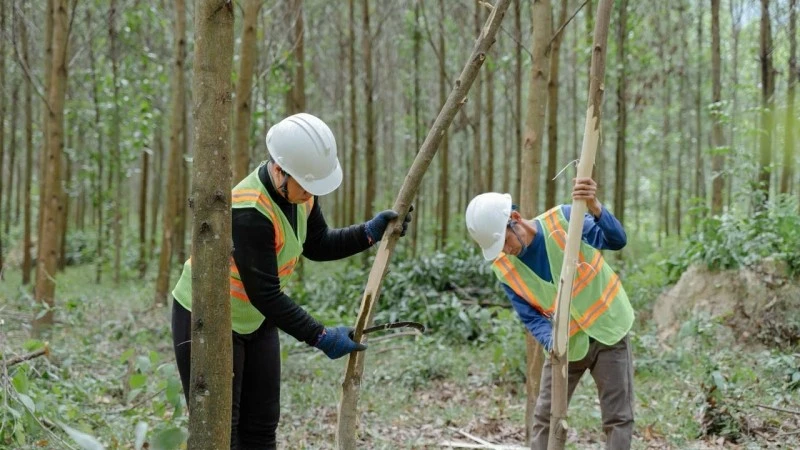Forestry economy developed through value chains
As one of the three pillars of the agricultural sector, alongside livestock and fisheries, forestry has gradually emerged as a “billion-dollar” export industry.

Changes in forest management practices, increased application of processing technologies, and the development of forestry along value chains are expected to boost the sector’s growth beyond the current 4.7–5% per year, with the goal of eventually reaching double-digit growth.
The Prime Minister has approved the National Plan for the Development of the Multi-Use Value of Forest Ecosystems through 2030, with a vision toward 2050. The plan aims to sustainably utilise forest resources, create jobs, and improve the material and spiritual lives of ethnic minorities, mountain residents, forestry workers, and people living near forests.
Building sustainable forest livelihoods
The plan targets that by 2030, domestic timber harvests will meet at least 80% of the raw material needs of the wood processing industry, increasing to 100% by 2050. Furthermore, 100% of wood and wood products must be sourced from legal timber and comply with both export and domestic market standards. As part of the plan’s implementation, forested provinces have intensified efforts to manage and develop sustainable forests.
In the area formerly known as Bac Giang province (now Bac Ninh province), four enterprises are managing over 9,000 hectares of forest and forest land: Mai Son One Member Limited Liability Forestry Company, Luc Nam One Member Limited Liability Company, Luc Ngan Two Member Limited Liability Forestry Company, and Yen The Two Member Limited Liability Forestry Company.
According to Bắc Ninh Provincial Department of Agriculture and Environment, in recent years, these entities have strengthened forestry seed management, introduced new tree varieties, and implemented intensive afforestation, as well as integrated agricultural, forestry, and aquaculture production. These efforts have improved both the productivity and quality of planted forests, contributing to the local economy.
Scientific and technical advances have also been applied, from improved plant varieties to mechanised clearing, pit digging, and timber harvesting. As a result, labour productivity and wood yield have been increased. Timber volumes have risen from 75–80 cubic metres per hectare per cycle to 110–125 cubic metres per hectare per cycle, significantly enhancing production efficiency and income for staff and workers.
Similarly, in Ca Mau province, the forestry economy has demonstrated sustainable development in recent years. In the U Minh Hạ region, planted forest yields have reached 90–180 cubic metres per hectare per cycle (lasting four to six years), helping to supply materials to the market and wood processing industry. Forest-dependent livelihoods have been stabilised thanks to changes in crop structure and a shift from extensive melaleuca plantations to raised-bed planting methods that reduce waterlogging, thereby boosting output two to three times.
Tran Ngoc Thao, Director of U Minh Ha One Member Limited Liability Forestry Company (Ca Mau province), which manages more than 24,000 hectares of forest land, noted that locals have diversified their incomes through various forestry-related activities such as planting, harvesting, transporting, and marketing timber.
Integrated forestry–aquaculture models (including honey collection, growing medicinal plants under forest canopies, cultivating vegetables, and aquaculture) have added 2–3 million VND per hectare annually. These activities have helped stabilise livelihoods for 2,418 contracted households, particularly poor and ethnic minority families.

In the context of rising global trade protectionism, sustainable forest management that meets export market requirements for origin and forest certification has become a key factor for the sustainable development of the forestry economy and value enhancement.
According to the Department of Forestry and Forest Protection, Viet Nam currently has more than 1 million hectares of acacia plantations, accounting for over 30% of the country’s total planted forest area. This serves as the primary raw material source for paper and pulp production, engineered wood, wood chips, and wooden furniture exports. To further increase economic value, premature logging should be minimised. Instead, plantations should be maintained for an additional five to six years, allowing them to mature into large timber forests. This can double the wood volume per hectare and result in a two- to threefold increase in selling prices.
Modernising production and expanding deep processing
According to the Ministry of Agriculture and Environment’s development plan for large timber plantations for the 2024–2030 period, Viet Nam aims to reach a total of around one million hectares of large timber production forests by 2030. The goal is to sustainably develop the supply of raw timber through intensive cultivation and expansion of large timber plantations, ensuring a stable material base for the wood processing industry.
To secure sustainable sources of raw material and develop the forestry economy along value chains, Vice Chairman and Secretary-General of the Viet Nam Timber and Forest Product Association Ngo Sy Hoai emphasised that forest-owning units must actively participate in sustainable forest management projects and obtain sustainable forest certifications. They should apply silvicultural techniques to convert plantations that produce small-diameter timber into forests supplying large-diametre timber, thereby improving the productivity and quality of planted forests. At the same time, sustainable forest management plans should be developed according to FSC and VFCS standards, enabling forest products to achieve higher economic value in the marketplace and contributing to better forest cultivation, sustainable management, and wood processing.
Deputy Minister of Agriculture and Environment Nguyen Quoc Tri highlighted that one of the key aspects of realising the multi-functional value of forest ecosystems is the effective implementation of forest carbon sequestration and storage services. However, the forestry sector currently faces a range of challenges amid rising global trade protectionism and the introduction of new export regulations for timber and timber products in key markets such as the US, Japan, the Republic of Korea, and European Union countries.
In this context, stakeholders must enhance their capacity for risk governance and trade defence, improve access to finance, and build sustainable value chains, from afforestation and processing to the development of distribution systems in both traditional and key international markets. At the same time, caution is required regarding input materials sourced from countries currently facing US tariff sanctions.
These challenges also present opportunities for domestic forestry producers to promptly shift their mindset in line with international practices. This includes diversifying export markets, reducing production costs, and transforming business models, moving away from contract manufacturing based on importer specifications toward proactive product design, brand development, and market differentiation, in order to improve business efficiency and increase profit margins.








